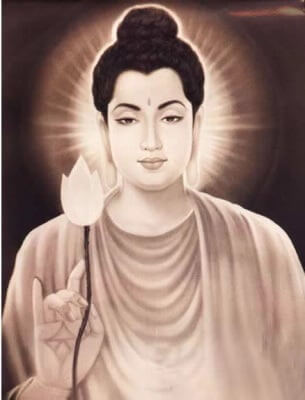There’s an ancient story about Buddha’s most powerful sermon, one in which he spoke no words. In this sermon, often referred to as the "Flower Sermon," Buddha simply held up a flower before his disciples, gazing at it in profound silence. While the gesture seemed simple on the surface, its deeper meaning rippled through those present. One disciple, Mahākāśyapa, smiled in understanding, grasping the essence of what Buddha was conveying without words. It was a moment of profound spiritual transmission, a direct experience of life’s aliveness and the interconnectedness of all things.
What Buddha revealed in that simple act was that life itself is the teaching—the profound mystery, beauty, and truth of existence is found not in words or explanations, but in the direct experience of the present moment.

The Power of Presence
When Buddha held up the flower, he wasn’t teaching his disciples about the flower. He was showing them how to be with life, how to observe the present moment with an open heart, and how to embrace the simplicity and aliveness in everything around them. His silent message was clear: life, in all its forms, is sacred, and the way we perceive and interact with it shapes our inner world.
The flower symbolized the essence of life—its beauty, fragility, and impermanence. Buddha’s gaze on the flower was a reminder that we too often get caught up in trying to intellectualize, explain, or judge our experiences rather than simply being present with them.
Life is a Reflection of Our Awareness
In that moment, Buddha invited everyone to shift their awareness—to step outside the mental chatter and embrace the raw aliveness of life. His message wasn’t just about seeing the flower but experiencing it fully: its color, its texture, its fragrance, its stillness. Life is always reflecting back to us our level of awareness. The deeper we look, the more we see, feel, and understand the true nature of existence.
Just as Buddha saw the wholeness of life in a simple flower, we are also called to recognize the richness of our own experiences, both big and small. The lesson isn’t confined to a meditation cushion or a spiritual setting; it extends to every moment of our daily lives.
The Aliveness of the Present Moment
The essence of the Flower Sermon lies in its reminder to reconnect with the aliveness of the present moment. Every moment of life holds potential, beauty, and wonder. Whether it’s the sight of a blooming flower, the sound of wind through the trees, or the warmth of sunlight on our skin, each experience invites us to wake up from our automatic responses and fully engage with life’s mystery.
We often forget that life itself is the greatest message. We get distracted by our desires, fears, goals, and endless thinking, losing sight of the fact that everything we seek is already right in front of us—if only we have the eyes to see it.
Beyond Words: The Silent Language of Life
One of the most profound aspects of the Flower Sermon is that it was delivered without words. In a world where language often dominates how we relate to each other and ourselves, Buddha’s wordless teaching reminds us of the limitations of language when it comes to expressing the deepest truths of existence. Life is often beyond words—it’s felt, seen, and experienced on a level that transcends intellectual understanding.
True wisdom often comes not from speaking, but from listening, observing, and simply being present. Silence allows us to connect with life in its purest form, without the filters of thought and judgment. In silence, we can feel the aliveness that courses through everything, including ourselves.
Seeing with New Eyes
The lesson of the Flower Sermon is ultimately about how we see and experience life. We are all capable of shifting our perspective, of learning to look at the world with new eyes—eyes that see beyond the surface and into the heart of existence. When we do this, every moment becomes an opportunity for insight, connection, and transformation.
As Buddha held up the flower, he was demonstrating that enlightenment doesn’t come from intellectual understanding or complex teachings. It comes from realizing the aliveness of everything around us and within us. The present moment holds the key to this understanding, and when we fully inhabit it, we can see the wonder and beauty that exists in even the smallest details of life.
Conclusion: Life is Our Greatest Message
Buddha’s silent Flower Sermon continues to resonate with us today because it points to a truth that transcends time, culture, and belief systems. The way we live, the way we perceive, and the way we feel is our greatest message to the world. Life is speaking to us all the time—through the breeze, through the laughter of a friend, through the stillness of a flower.
By cultivating the ability to be present, we tap into the wisdom and beauty that is always available to us. We stop seeking answers outside of ourselves and begin to experience life as it truly is—alive, interconnected, and full of wonder. This is the message that Buddha silently conveyed, and it is the message that life continues to offer us in every moment. All we have to do is listen

